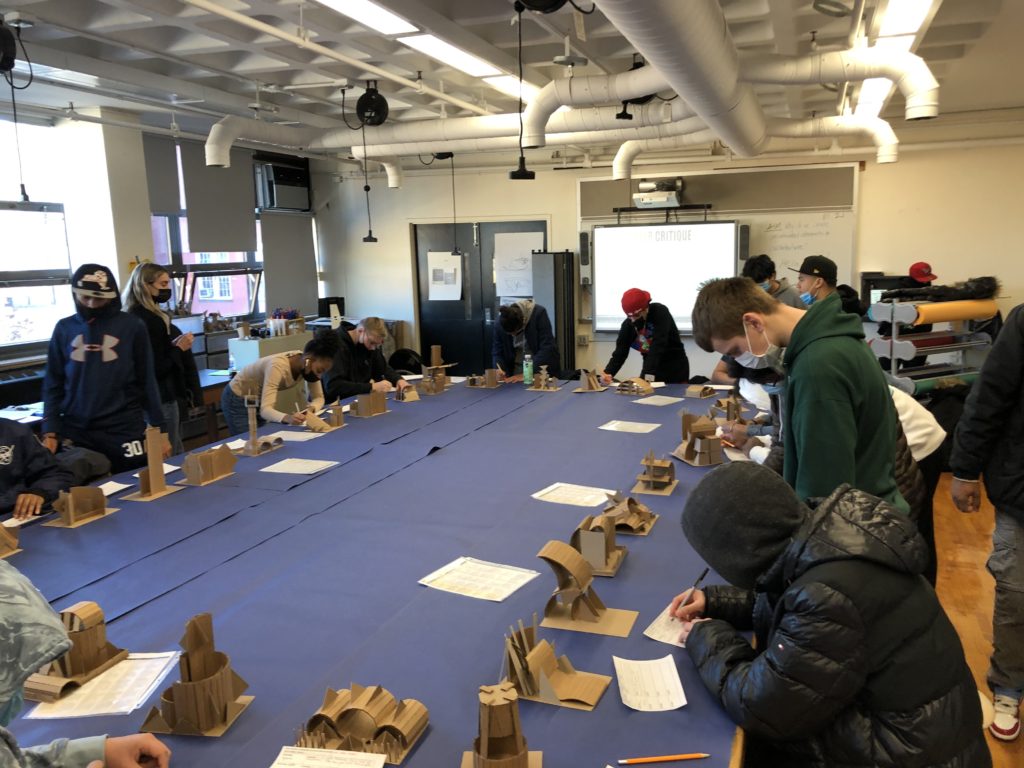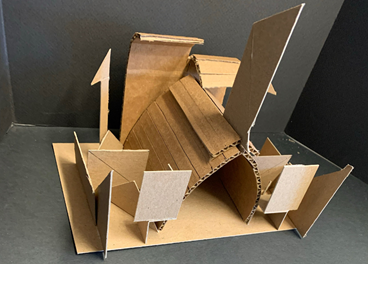
Students during their third year of architecture were challenged to create a 3-D model of a building or structure made entirely out of cardboard. The requirements of this project were to create two scored pieces of cardboard and ten rectangular or square pieces along with ten triangular pieces of cardboard. While working on this project, students were also given tools such as an x-acto knife and a paper cutter (abbreviated as CARL). The purpose of this activity was to test student’s ability to design while having the liberty of creative freedom. This type of activity is also commonly found during real life projects that architects work on.
When asked to create an artist statement on their designs, students answered three main questions: what was their inspiration, what was their design process/building purpose, and, finally, how did they incorporate the principles of design as well as their skills – techniques and materials.
Danila Stramavus:
What stands out about your design? What influenced your design? Does your design have a purpose?
- What really stands out about my structure is the asymmetrical design I incorporated, and the triangles that are injected into the corrugated cardboard. Regarding what influenced my design for the piece? Well, I didn’t have anything planned. I simply glued the pieces together and hoped the product would look somewhat attractive, and regarding what purpose my structure serves? Well, its purpose is to be put on a shelf and be forgotten about.
How would you describe the skills and tools you used to create your cardboard architecture sculpture? What was the biggest challenge, and one aspect that can be improved?
- The tools that I used were rather complicated to work with. For me, using the x-acto knife was rather challenging to be precise with, because it kept on sliding away and cutting that wasn’t aligned with the pencil marking. The biggest challenge was making a structure with the given pieces. Like I said, I didn’t have a creative structure in mind, and thinking of one was rather difficult.
Describe the design principles and building techniques you used? What skills and techniques did you learn? How would you further incorporate newly learnt skills into future works?
- I placed two corrugated pieces of cardboard on either end and glued several triangles in between, creating a pyramid like structure, and on one of the pieces of corrugated cardboard, I glued 10 tiny rectangles to the side, giving it some design aspect. That precision is key and it’s really important to make the structure you’re making look elegant.
Richard Hernandez:
Describe your cardboard architectural sculpture. Think of your description as a conversation with visitors, who know nothing about the project.
What stands out about your design?
- What stands out about my design is that instead of expanding outward it expands upwards.
What influenced your design? Does your design have a purpose?
- The feedback from my peers and teachers helped influence the outcome of my design. My design doesn’t really have a purpose.
Describe your process of creating the prefabricated elements (curves and identical shapes)? What did you do first? What did you do next? Describe the skills, materials, and tools you used?
- For this sculpture I made identical triangles and squares out of chipboard with precision by using a cutting mat to measure the size for each shape and once I marked it with a pencil I used CARL to cut out the shapes. With my x-acto knife I was able to score the corrugated cardboard to be able to make it bend and used those pieces as my wall. Once I had all my pieces, I used repetition and symmetry to create a sense of unity with my sculpture.
How can you apply the skills and techniques learned designing and building your next cardboard architecture models?
- I can use the skills and knowledge I got from doing this project and apply them to my next model by trying to use other principles of design to create unity and try to make other shapes to make my sculpture abstract.
Mohammad Hassan:
Describe your cardboard architectural sculpture. Think of your description as a conversation with visitors, who
know nothing about the project.
What stands out about your design?
- One thing that stands out of my design is that it looks like a symmetrical and balanced church or kingdom.
What were you asked to design?
- I was asked to design a structure with a minimum of two pieces of corrugated cardboard while utilizing ten squares/rectangles and ten triangles with an x-acto knife.
What influenced your design? Does your design have a purpose?
- To be completely honest, there was no true influence on my design because I created the structure as I went along cutting all my pieces. I utilized this method because I feel my creativity is a lot more expanded and broadened when there is no initial plan which brings about stress. The purpose of my design was not to create something specific, but see what my mind will create and put together without pre planning.
What technical and design skills and techniques did you learn while creating your model? How can you apply the skills and techniques learned in future projects?
- Some techniques I learned by creating my sculpture are how to utilize my ruler to get a more precise cut with my x-acto knife. I also learned how to score properly without cutting in too deep and I learned how to create a curve using corrugated cardboard. I can apply the skills and techniques I learned designing and building on my next model by learning from the minor errors I made and address those mistakes on my first model to know what techniques to avoid and use the techniques that give me a more appealing and clean design.
How did you develop your design?
- The first thing I designed was the curve in the middle of my sculpture. Once I did that, I cut out my ten triangles and ten squares/rectangles and began gluing them down even on both sides. I glued some of the triangles and squares together to create some form of unity and created an identical piece of the glued triangle and square/rectangle on the opposite side of the sculpture. Finally, I added another curve on the back of the sculpture but only cut it half way and curved it to create a sense of movement.
What was the biggest challenge you had while designing your model? Describe one aspect you can improve in future models and projects?
- One of the biggest challenges in creating and designing my cardboard sculpture was being able to have symmetry on both sides of my design when split in half. One aspect I can improve on for my next model is adding more curves and fewer geometrical shapes to create something more abstract.




